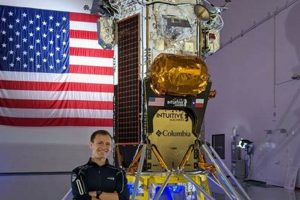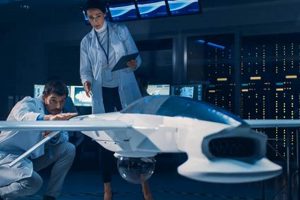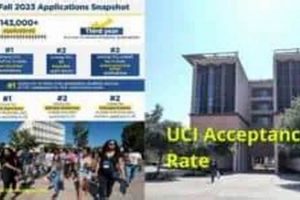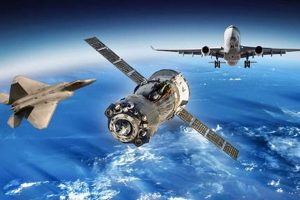The typical duration for completing a bachelor’s degree in aerospace engineering is four years. This timeframe allows students to acquire a foundational understanding of mathematics, physics, and core engineering principles specific to aerospace systems. For example, students will engage in coursework covering aerodynamics, propulsion, structures, and control systems, culminating in a capstone design project.
A significant advantage of pursuing formal education in this field is the structured learning environment, which provides a blend of theoretical knowledge and practical application. Completion of the bachelor’s degree often opens doors to entry-level positions within the aerospace industry or serves as a springboard for advanced studies. Historically, formalized engineering education has consistently produced qualified professionals prepared to innovate and contribute to advancements in aviation and space exploration.
The subsequent sections will delve into specific degree levels, potential accelerated programs, and the impact of specialization on the overall length of study. It will also address the implications of graduate studies and the continuous learning required to maintain professional competency within this rapidly evolving discipline.
Tips Regarding the Duration of Aerospace Engineering Studies
The following recommendations offer guidance for effectively navigating the academic path and optimizing the time investment associated with pursuing a degree in aerospace engineering.
Tip 1: Plan Coursework Strategically: Efficient use of academic resources mandates a well-structured plan for course selection. Consult with academic advisors to ensure prerequisites are met in a timely manner and to avoid unnecessary course repetitions. Example: Utilizing summer courses to accelerate progress through general education requirements.
Tip 2: Master Foundational Concepts Early: A strong grasp of mathematics and physics is essential. Invest time in thoroughly understanding these core subjects early in the curriculum. Example: Utilize tutoring services or supplemental materials to address areas of weakness in calculus or linear algebra.
Tip 3: Engage in Hands-On Projects: Practical experience complements theoretical knowledge. Seek opportunities to participate in engineering projects, research labs, or student organizations. Example: Joining a student chapter of the American Institute of Aeronautics and Astronautics (AIAA) and participating in design competitions.
Tip 4: Leverage Internships and Co-ops: Gaining industry experience during academic studies provides invaluable insights and potential career pathways. Actively pursue internship and co-op opportunities with aerospace companies or research institutions. Example: Applying for a summer internship at a NASA center or a major aerospace manufacturer.
Tip 5: Maintain Academic Performance: Consistent effort and dedication to academic studies are crucial. Aim for a high GPA to enhance career prospects and potential for graduate studies. Example: Dedicate specific study hours each day and prioritize academic tasks over social activities.
Tip 6: Network with Professionals: Building connections within the aerospace industry can provide mentorship and potential job opportunities. Attend industry events and career fairs. Example: Participating in conferences and workshops organized by professional engineering societies.
By implementing these strategies, students can maximize the effectiveness of their academic journey in aerospace engineering and potentially complete their studies within the standard timeframe, while also positioning themselves for successful careers.
The subsequent section provides concluding remarks on the importance of a well-planned approach to education and the long-term benefits of pursuing a career in the aerospace sector.
1. Four-year bachelor's is typical
The prevailing standard within higher education dictates that a bachelor’s degree in aerospace engineering requires approximately four years of full-time study. This temporal benchmark represents the most common pathway for individuals seeking entry into the profession. The structured curriculum, encompassing foundational science and engineering principles, requires a significant time commitment to achieve the requisite level of competence. For instance, the accredited aerospace engineering programs at institutions such as MIT, Stanford, and the University of Michigan adhere to this four-year structure. Deviation from this timeframe is possible through accelerated programs, but such options demand a greater intensity of study.
The reason “Four-year bachelor’s is typical” aligns so closely with the question of how long it takes to study aerospace engineering stems from the necessary breadth and depth of knowledge acquisition. The curriculum involves mathematics, physics, materials science, aerodynamics, propulsion, control systems, and design. Effectively internalizing these concepts, combined with practical application through laboratory work and projects, necessitates a considerable duration. A shorter timeframe would likely compromise the quality and comprehensiveness of the education. An exception may be an individual with prior related credits (e.g. military training), and it may be possible to enter an accelerated program.
In conclusion, while alternative paths exist, the four-year bachelor’s degree remains the modal and most widely recognized route to becoming an aerospace engineer. Understanding this typical duration is crucial for planning academic and career trajectories. The length of study is not arbitrary but reflects the inherent complexities of the field and the need for a robust educational foundation. Though the duration may vary slightly based on individual circumstances or institutional differences, the four-year standard provides a reliable estimate of the commitment required.
2. Accelerated programs offer alternatives
Accelerated programs represent a deviation from the standard four-year timeline for a bachelor’s degree in aerospace engineering, providing an alternative path for highly motivated and prepared students. These programs condense the curriculum, enabling completion in a shorter duration, thereby directly impacting the answer to the question of how long it takes to study aerospace engineering. However, participation necessitates a significantly increased workload and may not be suitable for all students.
- Intensive Course Load
Accelerated programs typically involve a higher number of credit hours per semester or term compared to traditional programs. This intensive course load requires exceptional time management skills and academic aptitude. For example, a standard semester might involve 15 credit hours, while an accelerated program could require 18 or more. This concentrated study demands greater focus and dedication, reducing the time needed for degree completion.
- Summer Coursework
To compress the curriculum, accelerated programs frequently incorporate summer coursework as a mandatory component. This allows students to continue their studies throughout the year, eliminating traditional breaks and shortening the overall timeframe. Attending summer classes allows for the material to be taught over several less intensive blocks throughout the year. Summer programs remove down time for the students and allows them to stay abreast of their studies.
- Reduced Electives
In some instances, accelerated programs may reduce the number of elective courses available to students. This allows for greater focus on core aerospace engineering subjects, streamlining the curriculum and facilitating faster progress. In turn, this also removes the opportunity for students to become well rounded.
- Prerequisites and Eligibility
Accelerated programs often have stringent admission requirements, including a high GPA and strong performance in prerequisite courses. This ensures that only students with the necessary academic foundation and aptitude are admitted. These prerequisites ensure that the applicant has some basic understanding of the material and has what it takes to succeed.
The availability and structure of accelerated aerospace engineering programs vary across institutions. While these programs offer the benefit of faster degree completion, prospective students must carefully consider the increased workload and potential impact on their academic performance and overall well-being. The decision to pursue an accelerated path should be based on a realistic assessment of one’s abilities and commitment to rigorous academic demands. Weighing the benefits of shorter study duration against the challenges of increased intensity is paramount when determining how long it will take to study aerospace engineering.
3. Master's adds two years
The completion of a Master of Science (M.S.) degree in aerospace engineering typically extends the duration of formal education by approximately two years beyond the four-year bachelor’s degree. This addition directly influences the answer to the question of how long it takes to study aerospace engineering, as it represents a significant augmentation of the overall educational investment. The pursuit of a master’s degree is often driven by a desire for specialized knowledge, enhanced research capabilities, and improved career prospects within the aerospace sector. The cause is the need for advanced knowledge, and the effect is an additional two years of study. For example, an aerospace engineer seeking expertise in computational fluid dynamics might pursue a master’s degree to gain in-depth understanding of numerical methods and turbulence modeling, skills not typically covered extensively at the undergraduate level. This increased expertise will make the individual a more valuable contributor, as many roles in the aerospace sector require specific knowledge not commonly obtained at the undergraduate level.
The practical significance of this two-year extension lies in the deepened technical expertise acquired during the master’s program. This advanced training often involves research projects, specialized coursework, and interactions with faculty experts, fostering a level of proficiency that enhances employability in specialized roles. These often come with higher salaries and the potential for advancement within an organization. For example, consider a graduate of the program. One might work on a project that advances satellite technology, or perhaps improving the safety of aircraft systems. A student in a Master’s program will also be expected to be able to provide a deeper and more thorough insight than an undergraduate student would in the same field.
In summary, the addition of two years for a Master’s degree represents a deliberate choice to acquire specialized knowledge and skills within aerospace engineering. This increased depth of understanding is instrumental in career advancement and contributions to innovative projects. While the additional time commitment is significant, the long-term benefits in terms of career opportunities and expertise often justify the extended period of study in response to the fundamental question of the total required investment in this field. The additional time investment may present challenges, such as increased tuition costs and delayed entry into the workforce, however, these are typically offset by the improved earning potential that comes with a Masters.
4. Doctorate extends study duration
The pursuit of a doctoral degree (Ph.D.) in aerospace engineering represents the most extensive academic undertaking within the field, significantly extending the duration of formal study beyond both the bachelor’s and master’s levels. This extension is a critical factor when considering the total time commitment required, directly impacting the answer to the question of how long it takes to study aerospace engineering.
- Research Focus and Dissertation
The core of a doctoral program revolves around independent, original research culminating in a dissertation. This research phase typically requires several years of dedicated effort, often ranging from three to five years beyond the master’s degree. For example, a doctoral candidate might spend years investigating novel materials for hypersonic flight or developing advanced control algorithms for autonomous spacecraft. The development of an original thesis is the main reason for the duration of the Ph.D. program.
- Advanced Coursework and Qualifying Exams
Before embarking on the dissertation research, doctoral students typically complete advanced coursework beyond the master’s level, designed to deepen their expertise in specialized areas. Furthermore, they must pass comprehensive qualifying exams to demonstrate mastery of the core curriculum. This foundational work ensures the student is capable of advanced study and research, thus requiring additional time. These exams are meant to check understanding of the core concepts as well as the specialized concepts for study.
- Funding and Assistantships
Many doctoral students are supported through research or teaching assistantships, which provide financial assistance in exchange for contributing to research projects or assisting with undergraduate instruction. While these assistantships can alleviate the financial burden of graduate study, they also add to the overall time commitment. The additional responsibilities will impact the students study time, and in turn, cause the program to take longer.
- Publication and Presentation
Doctoral programs often require students to publish their research findings in peer-reviewed journals and present their work at conferences. This process of disseminating knowledge is an integral part of the doctoral experience but also contributes to the overall length of study. The peer review process can take a long time to complete, and may need several rounds of revisions before being accepted for publication.
In conclusion, the pursuit of a Ph.D. in aerospace engineering substantially increases the time required for formal study. The extended duration reflects the emphasis on original research, advanced coursework, and the development of expertise necessary to make significant contributions to the field. Therefore, prospective doctoral students must carefully consider the considerable time commitment when planning their academic and career trajectories. The amount of time required is significant, yet worthwhile for those with a passion for original research.
5. Specializations can influence timeline
The choice of specialization within aerospace engineering exerts a tangible influence on the overall duration of academic study. This influence arises from the variable depth and breadth of knowledge required for different areas of expertise, ultimately affecting how long it takes to study aerospace engineering. Specific sub-disciplines may necessitate additional coursework, specialized research, or extended practical training, thus altering the standard academic trajectory.
- Advanced Propulsion Systems
Specializing in advanced propulsion systems, such as hypersonic engines or electric propulsion, frequently entails additional graduate-level coursework focused on thermodynamics, combustion, and plasma physics. The complexity of these systems and the need for specialized laboratory facilities can extend the research phase, particularly at the doctoral level. For example, developing and testing a new scramjet design may require extended access to specialized wind tunnels and high-temperature testing equipment, prolonging the overall research timeline.
- Astrodynamics and Space Mission Design
A focus on astrodynamics and space mission design often necessitates advanced knowledge of orbital mechanics, celestial mechanics, and spacecraft trajectory optimization. Mastering these subjects and conducting original research in areas such as interplanetary mission planning or satellite constellation design can require additional time, especially if the research involves complex simulations or collaborations with space agencies. The development of novel trajectory optimization algorithms, for instance, may necessitate extensive computational resources and prolonged periods of code development and validation.
- Aerospace Structures and Materials
Specializing in aerospace structures and materials demands a thorough understanding of composite materials, finite element analysis, and structural dynamics. Research in this area might involve investigating the behavior of advanced materials under extreme conditions or developing novel structural designs for aircraft or spacecraft. Such research often requires extensive laboratory testing and sophisticated modeling techniques, potentially extending the time required for degree completion. The fabrication and testing of new composite materials for aircraft wings, for example, can involve iterative cycles of design, manufacturing, and destructive testing, each requiring significant time and resources.
- Autonomous Systems and Robotics
The rapidly evolving field of autonomous systems and robotics in aerospace engineering requires a blend of expertise in control theory, artificial intelligence, and sensor fusion. Developing autonomous flight control systems or robotic systems for space exploration often involves extensive software development and hardware integration, which can extend the research timeline. The development and testing of algorithms for autonomous navigation of unmanned aerial vehicles (UAVs), for example, requires substantial time for code development, simulation, and flight testing.
In conclusion, the selection of a specialization within aerospace engineering represents a pivotal decision that directly influences the time required to complete a degree. The depth and complexity of the chosen sub-discipline, coupled with the associated research demands, can significantly alter the overall academic timeline. Consequently, prospective students should carefully consider their interests and career goals when selecting a specialization, recognizing the potential impact on how long it takes to study aerospace engineering.
Frequently Asked Questions
The following section addresses common inquiries regarding the typical length of time required to pursue a degree in aerospace engineering. These answers are intended to provide clarity and guidance to prospective students and individuals considering a career in this field.
Question 1: Is a four-year bachelor’s degree the only path to becoming an aerospace engineer?
While a four-year Bachelor of Science in Aerospace Engineering is the most common and direct route, alternative pathways exist. Individuals with a bachelor’s degree in a closely related field, such as mechanical engineering or physics, may pursue a master’s degree in aerospace engineering. However, this indirect path might require additional prerequisite coursework.
Question 2: Can the duration of a bachelor’s program be shortened through advanced placement (AP) credits?
The application of AP credits towards a bachelor’s degree in aerospace engineering depends on the specific policies of the university. Many institutions grant credit for qualifying AP scores, potentially allowing students to skip introductory courses and accelerate their progress. However, the impact on the overall duration is often marginal, as the core aerospace engineering curriculum typically remains unchanged.
Question 3: How does co-operative education (co-op) affect the length of study?
Co-operative education programs, which integrate paid work experience into the academic curriculum, generally extend the overall duration of a bachelor’s degree. Students typically alternate between academic semesters and work terms, adding one or more semesters to the total length of study. However, the practical experience gained through co-op can be highly valuable for career prospects.
Question 4: Is a master’s degree necessary for a successful career in aerospace engineering?
A master’s degree is not strictly necessary for all aerospace engineering positions, but it can significantly enhance career opportunities and earning potential. Many specialized roles, particularly in research and development, often require or strongly prefer candidates with a master’s degree. The additional education demonstrates a deeper level of expertise and research capability.
Question 5: Does the choice of specialization impact the length of graduate studies?
Yes, the chosen specialization can influence the duration of graduate studies, particularly at the doctoral level. Highly specialized areas may require more extensive research, additional coursework, or access to unique facilities, potentially extending the time required to complete the degree.
Question 6: How long does it typically take to complete a Ph.D. in aerospace engineering after earning a bachelor’s degree?
The completion of a Ph.D. in aerospace engineering typically requires five to seven years of study beyond the bachelor’s degree. This timeframe includes advanced coursework, qualifying examinations, and the completion of original, independent research culminating in a dissertation. The specific duration depends on the complexity of the research topic and the student’s progress.
These FAQs provide a general overview of the time commitment involved in pursuing an aerospace engineering degree. Individual circumstances and institutional policies may lead to variations in the actual duration of study.
The subsequent section concludes this comprehensive exploration of the topic.
Concluding Remarks
The preceding sections have provided a comprehensive overview of the time investment required to pursue an education in aerospace engineering. The information presented underscores that the duration of study varies depending on the degree level pursued, the existence of accelerated programs, and the chosen specialization. While a four-year bachelor’s degree represents the foundational pathway, graduate studies, particularly at the doctoral level, significantly extend the commitment. Individual circumstances, such as the utilization of advanced placement credits or participation in co-operative education programs, may also influence the overall timeframe.
Prospective aerospace engineers should carefully consider their academic goals, career aspirations, and personal circumstances when determining the optimal educational path. A thorough understanding of the factors influencing the duration of study is essential for effective planning and maximizing the return on investment in this challenging yet rewarding field. The aerospace sector demands highly skilled professionals, and the time dedicated to acquiring the necessary expertise is a critical investment in future contributions to this dynamic and vital industry.







